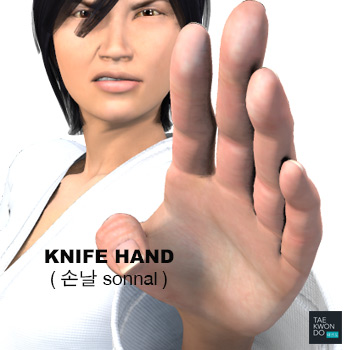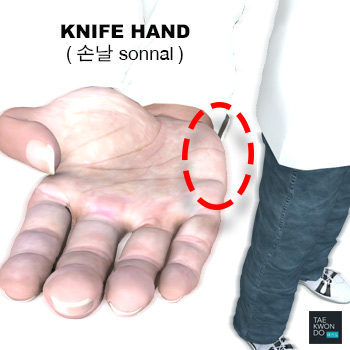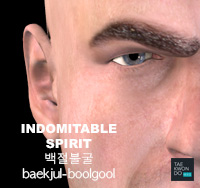Taekwondo 태권도Taekwondo Preschool
Promotion from one geup to the next can proceed rapidly in some schools, since schools often allow geup promotions every two, three, or four months. Students of geup rank learn the most basic techniques first, and then move on to more advanced techniques as they approach first dan. Many of the older and more traditional schools often take longer to allow students to test for higher ranks than newer, more contemporary schools, as they may not have the required testing intervals. View Taekwondo belt levels »
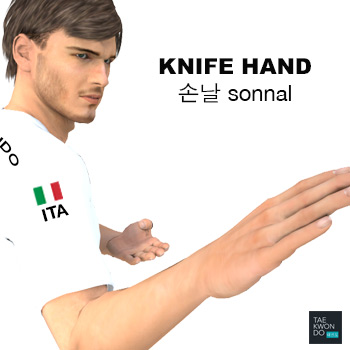
Knife Hand
( 손날 sonnal )
Difficulty Level: Intermediate Surface: Offensive and Defensive
By tucking the thumb into the palm, a striking surface called the knife hand or hand blade ( 손날 sonnal ) is formed. The striking surface extends with the muscle at the side of the hand located between the base of the small finger and the wrist (abductor digiti minimi). It is important to remember to keep the wrists straight, as if done improperly, the practitioner may well break their hands, wrist, or fingers.
The hand blade ( 손날 sonnal ) is used as both an offensive and defensive technique which can be executed as a high, low, middle, side, inward, outward, rising or circular. Use of this technique as both a strike and block is featured prominently in many of the World Taekwondo (WT) Taegeuk Poomse. Suitable targets for the knife hand strike include the mastoid muscles of the neck, the jugular, the throat, the collar bones, the third vertebra (key stone of the spinal column), the upper arm, the wrist, the elbow, and the knee cap.
Single Knife Hand Outward Block ( 한손날 바깥막기 hansonnal bakkat makgi ) is a blocking technique kept in a hand blade ( 손날 sonnal ) position to block attacks to the torso. The blocking arm is angled 90-120 degrees, wrist straight, and the hand blade ( 손날 sonnal ) is as high as the shoulder.
Some techniques that utilize the hand blade ( 손날 sonnal );
- Single Knifehand Outward Block ( 한손날 바깥막기 hansonnal-bakkat-makgi )
- Hand Blade Low Block ( 한손날 아래막기 sonnal-arae-makgi )
- Supported Hand Blade Block ( 손날 거들어 바깥막기 sonnal-kodureo-makgi )
- Supported Downward Hand Blade Block ( 손날 거들어 내려막기 sonnal-kodureo-naeryeo-makgi )
- Swallow Hand Blade Inward Strike ( 제비품 손날 안치기 jebipoom-sonnal-an-chigi )
- Hand Blade Outward Strike ( 손날 바깥치기 sonnal-olgul-bakkat-chigi )
- Hand Blade Side Strike ( 손날 옆치기 sonnal-yeop-chigi )
Training Methods
How well one improves with training depends on several factors, such as the frequency it is engaged in, and the type of feedback that is available for improvement. If a student does not train often enough, reinforcement fades, and he or she is likely to forget what was learned.
When learning the impact surface, it is helpful to use mirrors to observe your technique and fix your mistakes immediately. Initially, a student may need focused feedback from a certified Master Instructor ( 사범님 sabeomnim ); however, as they progress, they must develop the ability to self-assess the impact surface.
* Please see a certified Master Instructor ( 사범님 sabeomnim ) for training. Proper guidance and instructions are needed to ensure safe training.
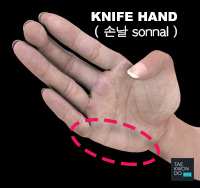
Training Safety Precautions
The Knife Hand ( 손날 sonnal ) can be used as both an offensive and defensive technique. It can be executed as a high, low, middle, side, inward, outward, rising or circular motion from both sides of the hand. A striking surface called the ridgehand ( 손날등 sonnal-deung ), or reverse knife-hand is formed by tucking the thumb into the palm, extending a few inches along the inside of the hand below the first knuckle of the first finger.
- Blocking ( 막기 makgi ) »: The act of stopping or deflecting an opponent's attack for the purpose of preventing injurious contact with the body. As the front arm sweeps down in an arc from the inside to the outside of the body, the hand is kept in a hand blade ( 손날 sonnal ) position to block attacks to the torso.
- Striking ( 치기 chigi ) »: Various surfaces of the hand may be engaged as the striking surface depending on which area of the opponent's body is being targeted. This leads to a large array of hand positions. The knife hand strike is executed by striking with the muscle at the side of the hand located between the base of the small finger and the wrist (abductor digiti minimi).
There are safety concerns with the Knife Hand ( 손날 sonnal ), so one should seek out an instructor. There are many small bones of the hand which need to be very carefully and slowly conditioned for safety.

Impact Surface Area
Various surfaces of the hand and feet may be engaged as the striking or blocking surface depending on which area of the opponents body is being targeted. This leads to a large array of hand and feet positions. The human body's shape is determined by a strong skeleton made of bone and cartilage, surrounded by fat, muscle, connective tissue, organs, and other structures. For more information View Impact Surface Area »
- Fist ( 주먹 jumeok )
- Hammer Fist ( 메주먹 mejumeok )
- Hand Blade ( 손날 sonnal )
- Ridgehand ( 손날등 sonnal-deung )
- Forearm ( 앞팔 ap-pal )
- Inner Wrist ( 안팔목 anpalmok )
- Outside Wrist ( 바깥팔목 bakkatpalmok )
- Elbow ( 팔굽 palgup )
- Back Knuckle ( 등주먹 deung-jumeok )
- Arm ( 팔 pal )
- Hand ( 손 son )
- Finger ( 손가락 songalag )
- Palm ( 손바닥 sonbadak )
- Palm Heel ( 바탕손 batangson )
- Fingertips ( 손끝 sonkkeut )
- Scissors Fingertips ( 가위손끝 kawisonkkeut )
- Combined Two Fingertips ( 모은두손끝 moeundusonkkeut )
- Single Fingertip ( 한손끝 hansonkkeut )
- Combined Three Fingertips ( 모은세손끝 moeunsesonkkeut )
- Flat Fingertips ( 편손끝 pyeonsonkkeut )
- Back Hand ( 손등 sondeung )
- Wrist Area ( 팔목 palmok )
- Back of the Wrist ( 등팔목 deung-palmok )
- Base of the Wrist or Inner Wrist ( 밑팔목 mitpalmok )
- Arc Hand ( 아금손 ageumson )
- Pincers Finger ( 집게주먹 jipgejumeok )
- Bent Wrist ( 굽힌손목 gupinsonmok )
- Curled Fingertips ( 모둠손끝 modumsonkkeut )
- Extended Knuckle Fist ( 밤주먹 bamjumeok )
- Half-clenched Fist ( 편주먹 pyeonjumeok )
- Trigger Finger Fist ( 집게밤주먹 jipgebamjumeok )
- Curled Hand ( 곰손 gomson )
- Foot ( 발 bal )
- Ball of the Foot ( 앞축 apchuk )
- Instep of the Foot ( 발등 baldeung )
- Bottom of the Heel ( 뒤축 dwichuk )
- Sole of the Foot ( 발바닥 balbadak )
- Foot Blade ( 발날 balnal )
- Shin ( 정강이 jeonggangi )
- Ankle ( 발목 balmog )
- Reverse Foot Blade ( 발날등 balnaldeung )
- Tips of the Toes ( 발끝 balkkeut )
- Knee ( 무릎 mureup )
- Back of the Heel ( 뒤꿈치 dwikkumchi )
- Back of the Knee ( 오금 ogum )
- Thigh ( 허벅지 heobeokji )
- Head ( 머리 meoli )
- Face ( 얼굴 eolgul )
- Human Eye ( 눈 nun )
- Ear ( 귀 gwi )
- Temple ( 관자놀이 gwanjanoli )
- Nose ( 코 ko )
- Teeth ( 이 i )
- Chin ( 턱 teog )
- Jaw ( 턱 teog )
- Throat ( 목구멍 mokgumeong )
- Neck ( 목 mok )
- Cervical Vertebrae ( 경추 gyeongchu )
- Shoulder ( 어깨 eokkae )
- Collarbone ( 쇄골 swaegol )
- Chest ( 가슴 gaseum )
- Ribs ( 늑골 neuggol )
- Sternum ( 흉골 hyung-gol )
- Abdomen ( 복부 bogbu )
- Groin ( 샅 sat )
- Hamstring ( 햄스트링 haemseuteuling )
There are five tenets defined in the International Taekwondo Federation (ITF) and several more in World Taekwondo (WT).
Indomitable Spirit ( 백절불굴 baekjul-boolgool ): "To have indomitable spirit means to have the courage to stand up for what you believe in, no matter what odds you are up against, and to always give 100% effort in whatever you do." View Taekwondo Tenets »
RESOURCES
This article uses material from the Wikipedia article "Knife Hand", which is released under the Creative Commons Attribution-Share-Alike License 3.0.


